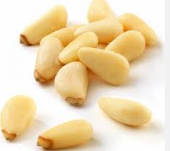Consider yourself lucky if a nasty taste is all that you have suffered after eating pesto, salad or other foods containing pine nuts. At least you’re not alone. Thousands of consumers in the U.S., Europe and elsewhere have complained that everything they drank, ate or chewed after eating even the smallest amount of pine nuts, tasted bitter, metallic, ‘crushed medicine-flavoured’ or indescribably disgusting—for days, weeks or months on end. Nor has an antidote or remedy been found for what came to be known by the unscientific name of “pine mouth.” Sufferers have even set up a Facebook group called “Damn You Pine Nuts.”
Although, as far as we know, the condition has not caused more severe or lasting harm to consumers than dysfunctional taste buds—a symptom that tends to go away on its own after a while—pine nuts have been banished from many restaurants and home kitchens for now. Cooks reluctant to give up the crunch have been substituting crushed walnuts, pistachios or other nuts and seeds in their pesto, salads and other recipes.
The mystery of this phenomenon was eventually solved. It seems that China – pine nuts biggest producer – had once again chosen to mix a toxic ingredient into its shipments of a food product, rather than lose revenue when demand for it exceeded its supply capacity. (Not unlike it did some years ago when Chinese dairy farmers watered down their milk and then boosted its protein content to required levels by spiking it with anti-freeze chemicals. The tainted milk ended up poisoning and in some cases killing thousands of babies and pets in China, as well as in many of its trading partner countries—including the U.S.)
Greed seems also to have motivated this latest toxic food calamity. During the 2008-09 harvest season, some Chinese suppliers found themselves short of edible pine nuts (known as Pinus Koraiensis and Pinus Cedar). So they padded their shipments with quantities o cheaper and inedible pine nuts, of a variety called Pinus Armandi. Incomprehensibly, they were fully aware that even a single toxic seed would contaminate an entire shipment of what otherwise would be an entirely safe delicacy.
The International Nut and Dried Fruit Association recently met with officials from the Chinese Chamber of Commerce to ensure that the country’s pine nut producers would never again ship the toxic mixture. In spite of this—as well as China’s assurance that “since November 2009, measures have been put into place to ensure that such mixing no longer takes place”- we advise you to substitute other nuts or seeds in recipes calling for pine nuts. Just to be on the safe side. At least until the tainted batches have been discarded or (forgive our skepticism) used up.
If you do experience post-pine nut symptoms, contact the Food Standards Agency (FSA), http://conversation.which.co.uk/consumer-rights/complaints-help-solve-pine-mouth-mystery/ or e-mail [email protected], for more information or to lodge a complaint. To vent or find fellow ‘pine nut victims,’ join Facebook’s “Damn You Pine Nuts” group.
TAKE TWO: Promises, Promises…
The U.S. Food and Drug Administration (FDA) is looking to share more information with its international counterparts, in an attempt to improve the safety of both domestic and imported food supplies.
In recent years, we have watched on TV a parade of FDA officials sitting in the hot seat at Congressional hearings, literally sweating their interrogations by often (at least seemingly) outraged lawmakers. The latter fumed and accused those responsible for the safety of American consumers of falling down on the job, while the FDA people admitted to fault, promised to do better and blamed depleted resources (i.e. inspectors), due to budget cuts. After both sides performed their parts and returned to their daily toil, toxic foods continued to be stocked on grocery store shelves.
Even those of us who are not from the “Show Me” state of Missouri might want to take a wait-and-see attitude until stepped-up FDA inspections show solid improvements in the safety and—dare we hope?—nutritional quality of our foods.
TAKE THREE: Time to Stand Up For Sustainable Agriculture
Now is the time to call or write and convince your Representatives and Senators to switch some funds from rich factory farm companies that don’t need Government subsidies, to organic farms that struggle to stay in business. Most of the latter are small, family owned and run enterprises that deserve long overdue Government support for their huge contributions to keeping their land, consumers and the environment healthy.
Find more information about the Government Farm Bill now being debated in Congress at http://www.ewg.org/farmsubsidies.
TAKE FOUR: How to Pick a Tasty Watermelon
If your way of selecting a watermelon is to tap it while trying to look like you know what you’re doing, it’s probably because you’ve seen your mother or spouse go through this strange ritual. Here are a few tips that not only will help you pick a good one, but build a reputation as an expert watermelon picker:
• Shape matters. Pick a symmetrical watermelon. A lopsided shape is a sign that the growing field did not get its full pollination share from the bees—whose job is sometimes interrupted by weather or other obstacles. Because of this, the narrower or misshapen parts of such watermelons might taste less sweet or flavorful.
• Color matters. Look at the watermelon’s “belly”—the part that sat on the ground. It should be a shade of butter-yellow. If it’s white, put it back.
• If you notice a black ring around the stem with a crystallized look, you’re holding a sweet watermelon, which had leaked a bit of its sugar when it was cut. Since sugar is carbon-based, it turns black when heated by the sun.
• Don’t know who came up with the idea to listen for a hollow sound when thumping a watermelon—it’s bogus. Instead, depending on the size of the watermelon and how strong your hand is, try to hold your selection in the palm of one hand and if you feel a vibration when you slap the watermelon several times with your other hand, you’ve got a solid specimen, filled with juicy flesh.
Enjoy.



2 Comments on “SHORT TAKES: Toxic Pine Nuts From China”
Contamination of dairy products in China in 2008 was from tainted scrap industrial melamine, and not antifreeze chemicals. Tens of thousands of babies became ill and probably have long term health concerns from kidney damage, although the number of reported deaths was small.
Pine nuts can also cause severe stomach pains and bleeding from the bowel. Maybe only when used with the toxic nuts from the Red pine, which are not at all edible, but how can you know? You can’t. Be careful and be aware.